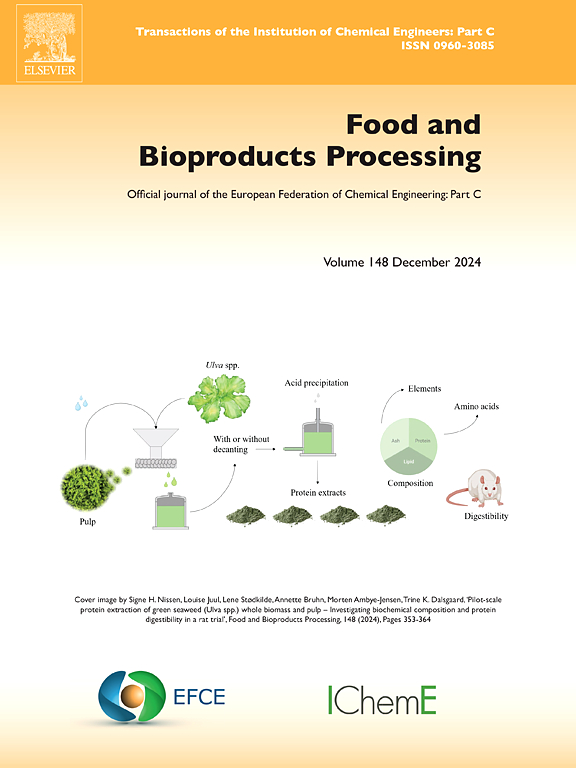Optimization of ohmic heating extraction of pectin from apple pomace and comparison with conventional method
IF 3.5
2区 农林科学
Q2 BIOTECHNOLOGY & APPLIED MICROBIOLOGY
引用次数: 0
Abstract
Apple pomace have economic potential for industry because of valuable components such as pectin. To enhance the extraction efficiency of apple pectin, in this study, pectin was obtained from apple pomace by Ohmic heating extraction (OHE) and the extraction conditions were optimized using response surface methodology (RSM). The yield and energy consumption of OHE and conventional extraction (CE) were compared under optimal conditions. The physicochemical properties of the two kinds of pectin and the commercial apple pectin (CAP) were characterized by analyzing their GalA content, degree of esterification (DE), crystallinity, thermal properties, functional groups, color, rheological and morphological characteristics. The optimized OHE conditions were voltage gradient of 14 V/cm, time of 102 min and temperature of 93 ℃. The pectin yield (PY) of OHE at the optimal conditions was 25.02 %, which was close to the predicted value (24.97 %). Compared with CE, OHE provided a 19.87 % increase in PY and a 37.53 % reduction in energy consumption. It can be considered that the non-thermal effect of ohmic heating might have accounted for these differences. FTIR analysis confirmed that there was no significant difference in the structure of the three kinds of pectin. CAP exhibited higher GalA content and DE while the extracted pectin had better thermal stability and viscoelastic properties. Overall, OHE can be considered as a promising pectin extraction technique with increased yield and reduced energy consumption compared to conventional methods.
欧姆加热提取苹果渣中果胶的工艺优化及与常规方法的比较
苹果渣由于含有果胶等有价值的成分而具有工业上的经济潜力。为了提高苹果果胶的提取效率,本研究采用欧姆加热提取法(OHE)从苹果渣中提取果胶,并利用响应面法(RSM)对提取条件进行优化。在最优条件下,比较了OHE法和常规提取法的产率和能耗。通过分析两种果胶的GalA含量、酯化度、结晶度、热性能、官能团、颜色、流变学和形态特征,对两种果胶和商品苹果果胶的理化性质进行了表征。优化后的OHE条件为电压梯度为14 V/cm,时间为102 min,温度为93℃。在最优条件下,OHE的果胶得率为25.02 %,与预测值24.97 %接近。与CE相比,OHE提供了19.87 %的PY增加和37.53 %的能耗减少。可以认为,欧姆加热的非热效应可能解释了这些差异。FTIR分析证实,三种果胶的结构没有显著差异。活性炭具有较高的GalA含量和DE,提取的果胶具有较好的热稳定性和粘弹性。总的来说,OHE是一种很有前途的果胶提取技术,与传统方法相比,它可以提高产量,降低能耗。
本文章由计算机程序翻译,如有差异,请以英文原文为准。
求助全文
约1分钟内获得全文
求助全文
来源期刊

Food and Bioproducts Processing
工程技术-工程:化工
CiteScore
9.70
自引率
4.30%
发文量
115
审稿时长
24 days
期刊介绍:
Official Journal of the European Federation of Chemical Engineering:
Part C
FBP aims to be the principal international journal for publication of high quality, original papers in the branches of engineering and science dedicated to the safe processing of biological products. It is the only journal to exploit the synergy between biotechnology, bioprocessing and food engineering.
Papers showing how research results can be used in engineering design, and accounts of experimental or theoretical research work bringing new perspectives to established principles, highlighting unsolved problems or indicating directions for future research, are particularly welcome. Contributions that deal with new developments in equipment or processes and that can be given quantitative expression are encouraged. The journal is especially interested in papers that extend the boundaries of food and bioproducts processing.
The journal has a strong emphasis on the interface between engineering and food or bioproducts. Papers that are not likely to be published are those:
• Primarily concerned with food formulation
• That use experimental design techniques to obtain response surfaces but gain little insight from them
• That are empirical and ignore established mechanistic models, e.g., empirical drying curves
• That are primarily concerned about sensory evaluation and colour
• Concern the extraction, encapsulation and/or antioxidant activity of a specific biological material without providing insight that could be applied to a similar but different material,
• Containing only chemical analyses of biological materials.
 求助内容:
求助内容: 应助结果提醒方式:
应助结果提醒方式:


